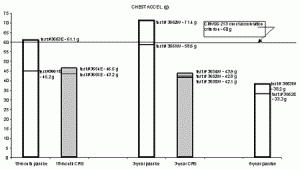7. RESULTS
The results are presented in Figures 2 and 3. For conciseness, these figures use CRS to refer to child restraint system and passive to refer to compartmentalization. The numerical results for each test appear beside the corresponding data point in the graphs. For the purposes of this paper, maximum values for head and chest accelerations are reported and analyzed.
The grey data bars in the graphs represent tests performed for properly installed child restraints securing the 18-month and 3-year dummies, whereas the white data bars represent tests performed with compartmentalization for the 18-month, 3-year and 6 year dummies.
For reference purposes, the acceptable levels for head and chest accelerations are 80 g and 60 g respectively (the horizontal line in Figures 2 and 3). These acceptable levels were adopted from the criteria for the 3-year dummy as specified in CMVSS 213.4 Built-in Child Restraint Systems and Built-in Booster Cushions26 and CMVSS 213 “Child Restraint Systems.27
7.1. Head Acceleration
Figure 2 presents head acceleration according to dummy size and the type of restraint system used. The head acceleration for every test for the 18-month dummy using a child restraint (two tests), the 3-year dummy using a child restraint (three tests) and the 6-year dummy using compartmentalization (two tests) were below the 80 g criterion, whereas every test for the 18-month dummy using compartmentalization (two tests) and the 3-year dummy using compartmentalization (two tests) were above the criterion. This indicates that children in Stages I and II would benefit from using a properly installed child restraint while travelling in a school bus.
7.2. Chest Acceleration
Figure 3 presents chest acceleration according to dummy size and the type of restraint system used. The chest acceleration for every test for the 18-month dummy using a child restraint (two tests), the 3-year dummy using a child restraint (three tests) and the 6-year dummy using compartmentalization (two tests) were below the 60 g criterion, whereas one of the two tests for the 18-month dummy and one of the two tests for the 3-year dummy using passive protection were above the criterion. This also indicates that children in Stages I and II would benefit from using a properly installed child restraint while travelling in a school bus.
Figure 2 - Head acceleration with respect to test dummy size and restraint use
Figure 3 - Chest acceleration with respect to test dummy size and restraint use
26 SOR/94-669, October 25, 1994.
27 Schedule 3 of Motor Vehicle Restraint Systems and Booster Cushions Safety Regulations (RSSR); SOR/98-159, March 12, 1998; SOR/98-524, October 22, 1998; SOR/2000-89, March 2, 2000; SOR/2001-341, September 20, 2001; SOR/2002-206, May 3 0, 2002.

